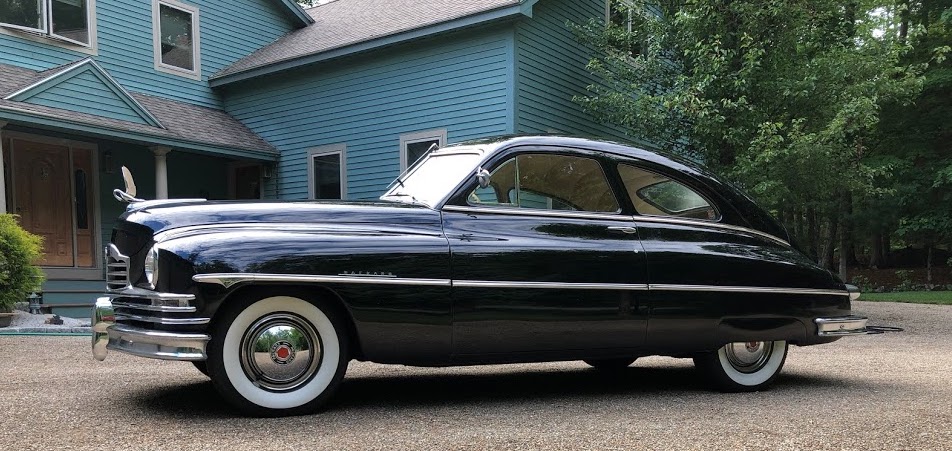
“Queen Mary”: We Love Our 1950 Packard Eight Club Sedan
“We love our Packard Eight Club Sedan” was first published in The Packard Cormorant 183, Second quarter 2021.
Early encounter
Over ten years ago on a Packard Club tour, we hitched a ride in a friend’s 1950 Packard Eight club sedan. Flipping a seatback, we “clambered” aboard. There are no assist grips in this bottom-line coupe, so you sort of walk in. It’s not hard to do because of the huge door opening.
We were bowled over by the ride—smooth and silent, enthroned on plush cushions which had recently been recovered with lookalike striped broadcloth out of a Chevy Master. I never forgot that ride. There wasn’t a sound out of the little 288 cubic-inch straight eight. The body was as solid as a bank vault—not a squeak nor a rattle anywhere.
Back in the day, my Dad always said coupes were tighter—if more impractical—than sedans. Riding in this big bathtub, I realized what he’d meant. It helped, of course, that the car was an original—showing about 50,000 miles. Our friend had tended its needs since 1984.
Searching for a ride
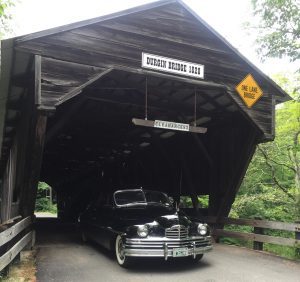 Back then we were enjoying a pretty 1936 One Twenty convertible, but after eight years, we’d had enough. The product of an age when most roads were still dirt, the One Twenty is happiest at 40 mph, running hard at 50, and straining at 60. Weather protection is rudimentary, especially if you don’t duct-tape the header where top meets windshield. After a drive through a thunderstorm on a narrow interstate with no wipers, 18-wheelers snorting past and water dripping on my knee, I decided that for long-haul touring, we needed something more modern.
Back then we were enjoying a pretty 1936 One Twenty convertible, but after eight years, we’d had enough. The product of an age when most roads were still dirt, the One Twenty is happiest at 40 mph, running hard at 50, and straining at 60. Weather protection is rudimentary, especially if you don’t duct-tape the header where top meets windshield. After a drive through a thunderstorm on a narrow interstate with no wipers, 18-wheelers snorting past and water dripping on my knee, I decided that for long-haul touring, we needed something more modern.
For awhile we substituted a ’53 Studebaker Commander Starliner, designed for Loewy by my old friend Bob Bourke. But a Studebaker is not a Packard. For all its svelte looks, the Starliner was still a cheap car, and drove like one. (Bob told me that if GM had built it, it would have been cheaper yet.) We also missed the genial camaraderie of Packard folk. So we sold the Stude and shopped around for another Packard—one that could handle modern highways and—mainly—keep the rain off my knee.
The Eight coupe: a perfect tour car
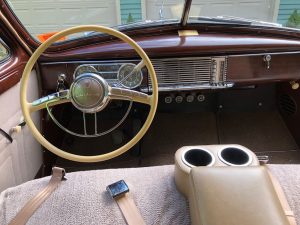
I’ve always loved the early postwar Packard Custom Super Clipper—the ideal combination of traditional styling hallmarks, the Clipper body, and the mighty, fabled 356 straight eight. Don Vorderman of Automobile Quarterly, the best editor I ever had, often said: “The Custom coupe is my idea of the perfect Packard. Wonderfully smooth big-ass straight eight and that graceful, swoopy shape. Doesn’t matter what color—they’re all gorgeous.”
There were two problems with this “new Packard concept,” as a pal quaintly put it. There are plenty of four-door Custom Clippers, but club sedans are rare. What’s more, they cost a fortune. I looked for awhile at sedans, but their lines while good are not quite as svelte as the coupes. Also, they rattled, and I hate rattles. That was when I remembered the 1950 Eight club sedan and the swift, silent ride we’d had in it.
I phoned the owner, got him at the right time. He was willing for us to see and drive it. Looking at it as a potential buyer, I realized that the coupe looks good even on a wheelbase seven inches shorter than the Custom’s. The flowing fastback lines help interdict the chubby body sides, and the mid-level chrome strip and pod-like taillights make the 1949-50 Twenty-third Series cars look more streamlined than their immediate predecessors. The driving was exactly as I remembered from our ride in it a decade ago. In a week or so, it was in our garage.
First impressions
There were a few minor surprises, but none we couldn’t handle. This is an original car, unrestored except for the upholstery. The old black lacquer paint shows areas of crazing, especially along the rear body sides. It’s a “20-footer”: from 20 feet away, it looks fabulous.
I’m told an expert could relacquer those rough spots, but I have yet to find anyone who would guarantee a perfect match. And as you know, there are a hundred shades of black. Then too, the patina of originality is something to be desired. How many 70+-year-old Packards do you see with their original paint?
I’d also forgotten—or maybe never realized—that this car had Ultramatic transmission. That’s your original, basic, down-home, Mark I Ultramatic, with all its faults and virtues. Its virtues are almost silent shifting and direct-drive in High. Unlike most early automatics, you get engine braking on a downgrade, just like a manual transmission. Its main fault is that it takes awhile to lurch into forward motion.
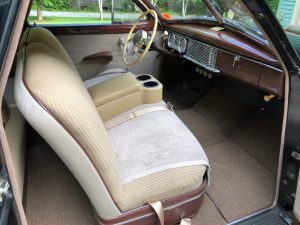 Waiting at a light in High, you need to issue the car an invitation. As the light is about to turn green you nudge the accelerator. The transmission likes to sigh and whine and get up some gumption before the off. You get used to this, but at first it’s disconcerting.
Waiting at a light in High, you need to issue the car an invitation. As the light is about to turn green you nudge the accelerator. The transmission likes to sigh and whine and get up some gumption before the off. You get used to this, but at first it’s disconcerting.
Back in the day, owners in a hurry would start in Low and shift to High once rolling. But as many found out, that causes an uncomfortable lurch and doesn’t lead to long-lived Ultramatics. (In 1954, Gear-Start Ultramatic fixed this with a Drive range between Low and High. It used the Low ratio and torque convertor to start off, switching to High and ultimately to direct drive as the car accelerated.)
Silky smooth, dead silent
Her owner called the big Eight “Proud Mary,” but we call her the “Queen Mary” for her bashful acceleration, roly-poly cornering and muscle-testing manual steering. There are five and a half turns lock to lock, and you really need to haul on that wheel. If it would not cause excommunication from Packard-dom, I’d retrofit power steering. Navigating this ship into port (that is, a parking space) is a test of muscle, patience and endurance.
Overall, of course, this only matters about 3% of the time. The great thing about the Packard Eight is the manner of its going: silky smooth and dead silent. As Tom McCahill said, it makes you think you’re riding in a bed of marshmallows. In a way, the ’50 Eight was the lineal successor to the old One Twenty, but a quantum leap forward in convenience and performance.
On the road
Performance may be described as “comfortable.” Zero to 60 must take 20 seconds, but we’ve never floored the old girl to find out. Nor have we pushed her over 70. Yet at 60, when our ’36 was panting, the ’50 Eight is just cruising. Gas mileage averages about 15 mpg, and the best I’ve done was 18. But hey, remember, this is 1950, and gas is only 15 cents a gallon. (A fun feature at filling stations: Packard’s “whistling gas tank” stops whistling when you’re nearing full, captivating bystanders. Nothing like that on an Audi A6.)
The Eight handles better than you would expect for a car of this vintage. There’s body roll, but once into high speed curves, she tracks sweetly and doesn’t toss you about. It helps that we have added a Packard Deluxe feature: center armrests. Obtained from CupHoldersPlus.com, they house two large drinks and a covered storage locker. It’s fun to hear people yet unborn when this car was new say: “I didn’t know they had cup holders back then.”
The dash isn’t as glitzy as its Custom cousin, but the woodgraining is beautiful. A forward step for the Twenty-third Series was illuminated switches, so you don’t have to fumble for them at night. Ordinarily it’s an upright driving position, but there is so much sheer room in that wide front seat that you can move around and find several comfortable positions. Visibility is good except to the rear quarters, where the fastback styling creates blind spots. The back windows, like most coupes of the day, don’t crank all the way down.
From Standard to Deluxe
The first thing I did was remove and sell the aftermarket bumper guards. I found they were so popular that I could have sold five pair. To me they just clutter her up—and there was a bonus: Having been covered since new, the chrome bumper guards underneath were pristine and unmarked.
Never able to leave good enough alone, I’ve been upgrading from Eight to Deluxe Eight equipment. The difference in price in 1950 was $134 ($1450 in today’s money). It bought a lot of nice extras.
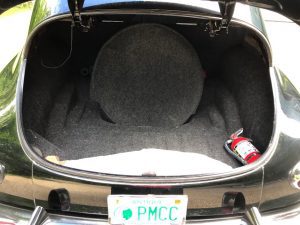
The standard Eight came with rubber front floor mats. A rustic elf carefully removed them, so they can always be put back. He installed Deluxe-style full carpeting (Mercedes-Benz material) front and rear. It really improves the ambience. While at it, I had him line the scruffy trunk compartment with form-fitted grey marine carpeting. Again, the original mat was carefully preserved. He had enough carpet left to make a spare tire cover, too. The headliner and door panels, recently replaced, needed nothing.
Several Packard friends said that a deluxe chrome-trimmed ivory steering wheel was a dealer option. I didn’t inquire into this too closely. For a cool $1600, a steering wheel specialist cast one from a core supplied by a friend. Looks like a million bucks! I sold the original steering wheel and took my friend to lunch. Kanter Auto Products supplied a set of Deluxe Eight wheel trim rings, to help glorify the tires—which are wide-white radials, by the way. They make a huge difference in handling compared to bias-plys.
Deluxe Eight parts wanted
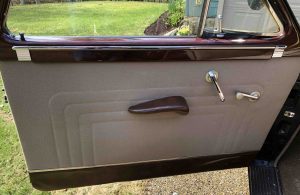
Given time and patience, I found a set of Deluxe Eight chrome-trimmed window reveal moldings, and genuine, stalky Twenty-third Series rearview mirrors. (This car lasted 68 years without outside mirrors, but our first ride on an Interstate made me slap on a temporary one.) Original mirrors, unique to this series, rare and expensive.
A Packard Club member supplied a rough set of interior window moldings. A talented woodgrainer in Florida made them look like new, while a plating expert in Connecticut restored the bright work. The improvement is palpable and beautiful. The only Deluxe fittings I haven’t yet found are the assist-grips which install on the “B” pillar for backseat passengers.
Back to the Fifties
I mentioned that this Eight is an original, low mileage car—it has just turned 55,000. And that is a real plus. Yes, there are flaws in the paint—but the bonus is: everything works! I mean, everything. Even the clock, which keeps perfect time—the former owner wisely installed a quartz movement.
Items that often pose problems for early postwar Packard owners behave like new. The knurled heater/defroster knobs turn easily and the vent knobs deliver blasts of fresh air, like God and Packard intended. (No old-fashioned cowl vents after 1948.) The heater is toasty warm, and the defroster spews enough warm air to defog the windshield. Most remarkable of all, the vacuum wipers continue to wipe, even under load. Driving the Eight in a downpour is therefore a pleasure—except for a pesky water leak under the center of the windshield. But much less water gets in than it did on my ’36.
The radio works, too—and the remote control aerial that neatly stores on the windshield divider. But it’s AM-only, and reception is dicey. Reluctantly—because there’s nothing like the rich, fat sound of old tube radios—we gave up on it. With Spotify and a Bluetooth sound box, we have fabulous audio of our choosing. Now Ella and Satchmo, Bing and Frank, Nat and Judy, echo the tunes that once reverberated over the Packard Eight’s speakers.
And that’s really what it’s all about, isn’t it? Driving such a car takes you back, to a simpler, quieter, more placid, more innocent time. All too soon you’re jerked back to the ever more disconcerting present. But behind that big ivory wheel, cruising to Vaughan Monroe’s mellow baritone, it’s 1950 all over again.
Miscellany
1950 Packard Eight 23rd Series Model 2395-5 Club Sedan
Original paint, 55,000 miles. Production: 5200. Wheelbase 120.” Weight 3800 lbs.
Straight eight, 4.7 liters, 288 cu. in., 135 bhp. Top speed: 90 mph. Mileage: 14-18 mpg.
List rice: $2409 including Ultramatic Drive ($28,000 in today’s money)
Packard’s first postwar redesign (1948) was based on the 1941-47 Packard Clipper, designed by Dutch Darrin and Werner Gubitz. Following the contemporary styling school, it was bullet-shaped and rounded, heavier looking than the Clipper.
In 1949 a mild facelift applied a body-length chrome strip and larger, more visible oval taillights. This standard Eight was the bottom of the 1950 line, which ranged up to the $4500 Custom Eight convertible. Its closest competition was the Oldsmobile 98.
Ultramatic Drive is a hydraulic automatic with “Direct Drive” torque converter lockup, designed by Forest MacFarland. The only automatic designed exclusively by an independent manufacturer, it delivers the same gas mileage and engine braking characteristics as a standard transmission.
Readers in search of top-quality woodgraining, carpeting or chrome plating even pitted pot metal parts may contact me for the excellent craftsmen I found.






